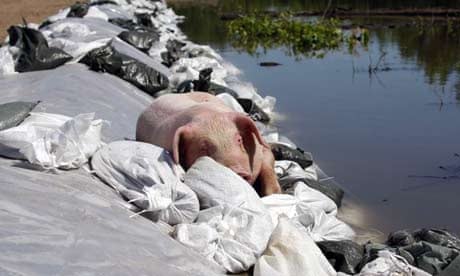Devastation caused by week-long flooding in America's farm belt is threatening to push up food prices which are already at record highs.
The cost of corn and soya beans has peaked on the US market amid concern of a shortfall in production. The midwest, one of the world's biggest corn-growing regions, has been hit by the worst flooding for 15 years. An estimated 16% of Iowa's grain crop has been destroyed.
Five other states have also been hit, with residents along the Mississippi in Illinois and Missouri frantically building up sandbag barriers yesterday to prevent further losses.
President George Bush and the Republican presidential candidate, John McCain, visited the devastated areas yesterday. Bush flew to Cedar Rapids, Iowa, which has suffered its worst ever flooding after the Cedar river overflowed, and then planned to continue by helicopter to view the farmland and small towns still under water.
Higher food prices, combined with a public outcry over a huge rise in petrol prices, will add to general disillusionment with the Bush presidency, and McCain, as the Republican candidate, could suffer from the association. McCain, who has been distancing himself from Bush, travelled separately to the flooded areas.
Twenty-four people have been killed and 148 injured. There have been at least two dozen breaches of the levees intended to prevent such flooding.
The army corps of engineers, which is responsible for the levees, predicted waters could flow over 20 or more levees over the next few days.
LeRoy Lippert, mayor of Danville, Iowa, said that after the floodwater receded, stricken farmers would have to work through until the autumn to clear silt, tree limbs and other debris before planting. "There's going to be absolutely no farming this year," he said. "They've lost it. It's gone. Nothing at all. No beans, no corn this year."
The prospect of smaller crops jolted the markets. Corn prices in the midwest have crept closer to an unprecedented $8(£4) a bushel, a fourfold increase.
World corn prices have risen to record highs and are 90% higher than they were a year ago. Estimates are that 2m hectares (5m acres) across the midwest have been ruined and will not produce a crop this year.
Farmers on land outside the affected areas said that the traders were panicking but that, so long as there were no more heavy rains, 90% of them would deliver their crops.
Corn and soya beans are used in processed food and are fed to cattle for meat production.
Some analysts said the reduction in grain output could force food prices even higher, or at least lock them in, at a time when many countries around the world are already struggling with the rising cost of basic foods.
Vic Lespinasse, a grain analyst at the Chicago Mercantile Exchange who produces a daily blog, said much depended on what happened next with the weather. "If the weather continues to be a problem, we could see $9 or even $10 a bushel corn, we could see $20 a bushel soybeans, so it all depends upon the weather."
Lespinasse also blames the weak dollar for pushing up the price of corn because other countries have more spending power in the international markets.
